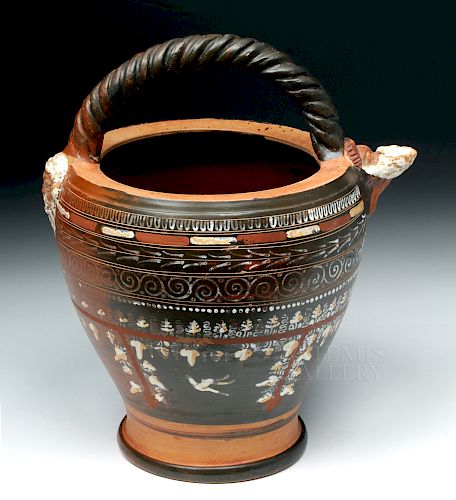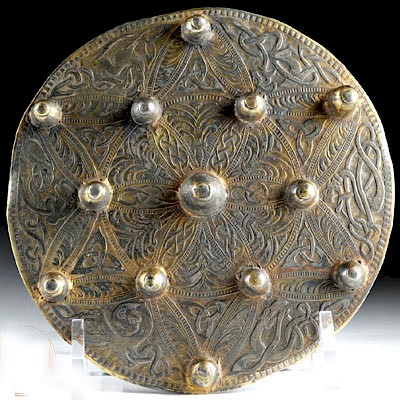Greek Gnathian Situla Toledo Painter ex-Christie's, TL
Lot 15
About Seller
Artemis Fine Arts
686 S Taylor Ave, Ste 106
Louisville, CO 80027
United States
Selling antiquities, ancient and ethnographic art online since 1993, Artemis Gallery specializes in Classical Antiquities (Egyptian, Greek, Roman, Near Eastern), Asian, Pre-Columbian, African / Tribal / Oceanographic art. Our extensive inventory includes pottery, stone, metal, wood, glass and textil...Read more
Estimate:
$15,000 - $20,000
Absentee vs Live bid
Two ways to bid:
- Leave a max absentee bid and the platform will bid on your behalf up to your maximum bid during the live auction.
- Bid live during the auction and your bids will be submitted real-time to the auctioneer.
Bid Increments
| Price | Bid Increment |
|---|---|
| $0 | $25 |
| $300 | $50 |
| $1,000 | $100 |
| $2,000 | $250 |
| $5,000 | $500 |
| $10,000 | $1,000 |
| $20,000 | $2,500 |
| $50,000 | $5,000 |
| $100,000 | $10,000 |
| $200,000 | $20,000 |
About Auction
By Artemis Fine Arts
Jul 19, 2018
Set Reminder
2018-07-19 10:00:00
2018-07-19 10:00:00
America/New_York
Bidsquare
Bidsquare : Fine Antiquities/Ethnographic Art
https://www.bidsquare.com/auctions/artemis-gallery/fine-antiquities-ethnographic-art-3329
Featuring classical antiquities, ancient and ethnographic art from cultures encompassing the globe, plus fine art. Artemis Fine Arts info@artemisgallery.com
Featuring classical antiquities, ancient and ethnographic art from cultures encompassing the globe, plus fine art. Artemis Fine Arts info@artemisgallery.com
- Lot Description
Magna Graecia, Apulian region of southern Italy, Gnathian, ca. 330 to 320 BCE. Attributed to the Toledo Painter, a tantalizing polychrome ceramic situla of a grand form with a twisted rope-like black handle, the spout depicting the head of a comedic or satyr theatre mask, with an open white bearded mouth, orange-yellow detailing of eyes on a red ground, and a textured red filet forming his coiffure or wreath. Inside the spout, behind the mouth, a strainer was added to catch irregularities in the contents of the situla. A mask of Papposilenos was added to the opposite side just beneath the handle. The exterior walls are painted and incised with multiple decorative registers including ovalo, filets, laurel leaves, dotted spiral waves, a beaded band, and abundant grapevines with doves, flowers, and budded tendrils in the field - all in added fugitive red, white, and yellow pigments against the black ground. Its concave foot is adorned with two crossed red bands on the underside. Size: 11" W at widest x 12.25" H (27.9 cm x 31.1 cm)
The Toledo Painter is named for a pair of oinochai and a situla in The Toledo Museum of Art. According to their curatorial team, vases attributed to this painter "show a luxury of color and mastery of design elements not usually seen in Gnathia ware." (see p. 27 in C.G. Boulter and K.T. Luckner, Corpus Vasorum Antiquorum, The Toledo Museum of Art, Fascicule 2). According to the Christies essay about this piece, "The example presented here features a mask of Papposilenos applied below one end of the handle, seemingly cast from the same mold used on the namesake situla, while the other end has a comedic mask serving as the spout."
Situlae with clay handles are quite rare. Vessels like this were used to mix water and wine. The shape was intended to imitate a metal bucket; see Rainer Vollkommer, Unteritalische Vasen. (Kleine Reihe des Antikenmuseums der Universität Leipzig, 2) (Leipzig, Universitätsverlag, 1995), p. 30, and Corpus Vasorum Antiquorum, Deutschland 72: Hannover, Kestner Museum 2, (München, C.H. Beck, 2000), pl. 57, 4-6; 58, 1-2. For additional information and comparisons see J. Richard Green, "Gnathia and Other Overpainted Wares of Italy and Sicily: a Survey", in Évelyne Geny (ed., sous la direction de Pierre Lévêque et Jean-Paul Morel), Céramiques Hellénistiques et Romaines III (Besançon, Presses Universitaires Franc-Comtoises, 2001), 57-103, esp. p. 89, no. 15) as well as Anneliese Kossatz-Deißmann, "Eine neue Phrygerkopf-Situla des Toledo-Malers", Archäologischer Anzeiger 1990 (Deutsches Archäologisches Institut), p. 505-520. A comparable spout can also be found in Leipzig, Antikenmuseum der Universität, inv. no. T951, see Vollkommer, o.c., p. 30-32, no. 18 (illustrated).
This piece has been tested using thermoluminescence (TL) and has been found to be ancient and of the period stated. A full report will accompany purchase.
Provenance: ex-Christies, New York, 25 October 2017, sale 14356, lot 100; ex- Manhattan, New York, USA private collection; ex- Herbert A. Cahn, Basel
All items legal to buy/sell under U.S. Statute covering cultural patrimony Code 2600, CHAPTER 14, and are guaranteed to be as described or your money back.
A Certificate of Authenticity will accompany all winning bids.
We ship worldwide and handle all shipping in-house for your convenience.
#129738Minor wear / loss to pigments; some areas show a red rather than black ground due to ancient misfiring.Condition
- Shipping Info
-
All shipping is handled in-house for your convenience. Your invoice from Artemis Gallery will include shipping calculation instructions. If in doubt, please inquire BEFORE bidding for estimated shipping costs for individual items.
-
- Buyer's Premium



 EUR
EUR CAD
CAD AUD
AUD GBP
GBP MXN
MXN HKD
HKD CNY
CNY MYR
MYR SEK
SEK SGD
SGD CHF
CHF THB
THB



















